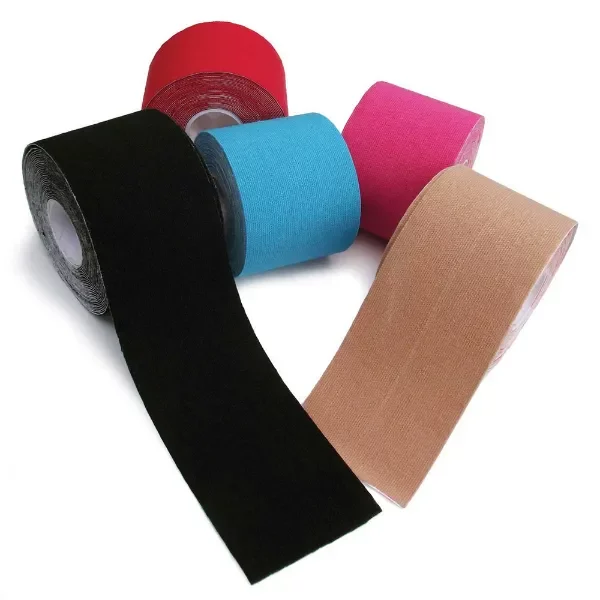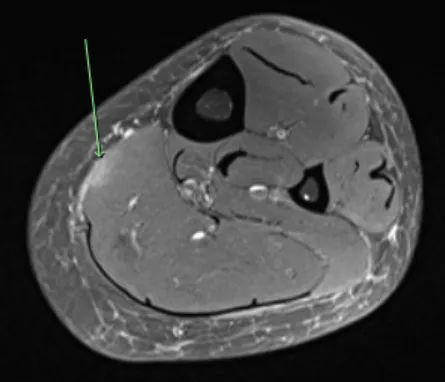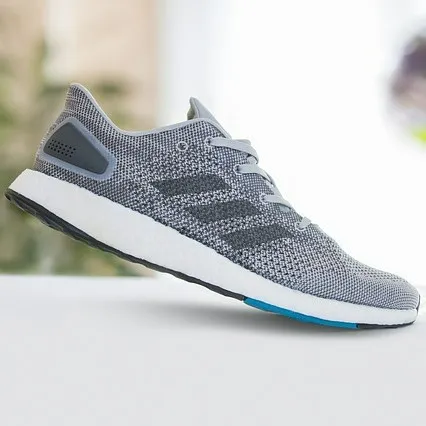Aside from the colourful patterns, can KT tape for calf pain really make a difference? And can it help with a calf strain?
KT tape, Kinesiology tape, Dynamic tape…there’s lots of brands and even more colour/pattern options. But what does it do and is it effective?
KT tape is often seen on sports stars and celebrity athletes, using it to manage calf pain or to recover from a calf strain.
But is it effective and can it help prevent calf strains or is it all just bright colours and marketing?
Let’s cover each part of those questions with answers from our Physiotherapists.
(If you’re only here to find cheap KT tape, follow the link to your country’s best offering.)

You can get a 16ft roll in a range of colors. It’s got a quality adhesive and water resistant & breathable material so it can be worn for days without any issues.
What’s the intended action of KT tape for calf pain?
The goal of KT tape for calf pain is to provide improved muscle control by using the body’s own systems.
The tape is an effective method of improving control of calf loading and ankle movement if the muscle function is normal.
It does this by using skin sensation to augment the feedback to the brain from tendons and joints.
Rather than judging how much the calf is loading based on the Achilles tendon stretch, the brain can also use information from the tape pulling on the skin.
But without a working muscle to act on that information, the benefit is lost.
In the case of a fresh calf muscle strain or tear, the extra feedback won’t help as the muscle isn’t able to work normally.

Providing the brain with more information on calf muscle stretch and pressure can be comforting and makes athletes feel more secure.
But because the muscle isn’t able to actively resist the stretch, it’s only a psychological support as the stretchy tape won’t physically resist the pull on the muscle.
As the injury progresses and recovers, KT tape can be quite effective as manging calf strains, as we detail in the next section…

Need a running shoe to help ease calf pain?
Our Physio experts have listed the key shoe features to look for if you’ve got calf pain, including recommended brands and models.
KT tape only works for 3 types of calf injuries!
It’s easy to notice runners using KT tape for calf pain – the bright colours typically give it away!
It seems that dynamic tape generally, including KT tape for calf pain, is seen as a cover-all fix.
However KT tape is only effective for 3 types of calf injuries – calf strains and overload like a soleus muscle injury, Achilles injuries and neural tension (or nerve) injuries like Sciatica.
This is due to the intended action of KT tape for calf pain and what it offers the runner.

You can get a 16ft roll in a range of colors. It’s got a quality adhesive and water resistant & breathable material so it can be worn for days without any issues.
It also means that KT tape for calf pain is ineffective for gastrocs muscle injuries (Gastrocs is the larger muscle at the top of the calf), shin splints, calf muscle overload issues and bone stress injuries.
That’s because the tape isn’t able to physically restrict or restrain movement.
So injuries that need an external support to prevent overload will benefit from rigid strapping tape rather than the more elastic dynamic tape.
(If you’re using KT tape for an Achilles injury, see our Achilles-specific analysis of KT tape here).

What’s causing your calf pain?
Just using KT tape for calf pain misses the point – you need to address the underlying cause of the injury.
If the calf pain is arising due to abnormal loading on the Achilles tendon, the tape improves the control of tendon forces by giving feedback on tendon stretch.
That can help temporarily and the injury may recover after a few weeks.
But using the tape as an ongoing “crutch” is a waste of time and money.
The brain is initially helped by the extra feedback but after a while, it comes to rely on it.
This creates a cycle where the brain learns to control the area with feedback from the tape so, without it, the problem is worse than ever.
It doesn’t happen instantly but if you’re still using the tape after a month, start to gradually reduce the reliance on tape and look for alternative methods.
In the case of calf pain due to bone loading and impact, taping your calf won’t change the impact loading on the bone.
It might distract you from the underlying pain for a short time – people often describe feeling more secure with the area taped up firmly.
But it’s not helping – it only masks the trouble while the injury continues to get worse.
We’ve got more detail on the causes of calf pain here, as well as how to differentiate between causes.
The most effective way to apply KT tape for calf pain or calf strains
When applying KT tape for calf pain, position the foot slightly pointed and add some light tension to the tape as you stick to to the skin.
Start from below the calf muscle – this may be from the lower Achilles tendon or, for more pressure, from under the heel. Stop the tape just below the knee.
Anchor each end of the tape by applying a circumferential tape around the foot/ankle and upper calf to hold the ends in place. Ensure this piece of tape wraps all the way around and sticks to itself.
To ensure you have the right tension, you should be able to stand up with only mild tension felt. That tension should increase as soon as you begin to squat (ie. ankle moving past 90 degrees).
If it doesn’t tighten up immediately, you can peel it off and restick the same piece of tape a few times before adhesion becomes a problem.

You can get a 16ft roll in a range of colors. It’s got a quality adhesive and water resistant & breathable material so it can be worn for days without any issues.
Is it working for you?
If you’re using KT tape for calf pain, you should know if it’s making a difference within 2-3 training sessions.
The improvement you’re looking for comes in different forms.
It might be that the pain starts later in the run, there’s less pain by the end of your usual run or the aching disappears quicker after the run.
But the change you’re looking for is clear and noticeable.
If the pain kicks in 500m later, that’s not a big enough change to declare victory.
If the pain gets to 4/10 at 5k, instead of 5/10 without the tape, it might just be wishful thinking.
As a general rule, you’re looking for a change in pain of at least 2/10 to make it likely to be more than chance.
KT tape for calf pain might work as soon as it goes on but sometimes it takes a while for the brain to adapt to the new input.
If it hasn’t made a difference after 3 sessions, don’t bother with the tape and save your money.
If it helps initially, you can gradually phase it out by reducing the number of strips of tape per application or just apply it lighter until it’s not required.
What KT tape can’t do
The tape is elastic, very elastic. It stretches easily and stretches further than muscles, tendons and skin.
So it’s unable to support any joints or movement. Tape might feel supportive but that’s the kind of support you get from a warm hug from Mum – not the support you need like an ankle brace or rigid strapping tape.
It won’t protect against excessive movement. Rigid strapping tape, used after ankle sprains, is designed to restrict movement and protect against excessive stretch.
KT tape for calf pain, or any elastic tape for that matter, is unable to provide any restriction or protection against excessive movement.
**Special note: this article has Physiotherapist-recommended products with affiliate links to trusted vendors, selected for their fast & reliable service and great prices. The article was written prior to sourcing the affiliate links and the links in no way influence our recommendations.
